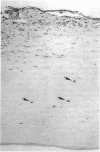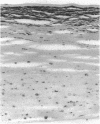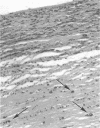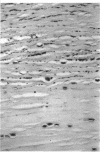Abstract
The results of a histopathological study of 30 cases of Acanthamoeba keratitis are construed as indicating a four stage pathogenetic sequence: (1) initial infection, involving breaching of the surface epithelium; (2) keratocyte depletion by the invading trophozoites; (3) inflammatory response mediated by neutrophil polymorphonuclear leucocytes; (4) stromal necrosis attributable to leucocytic activity.
Full text
PDF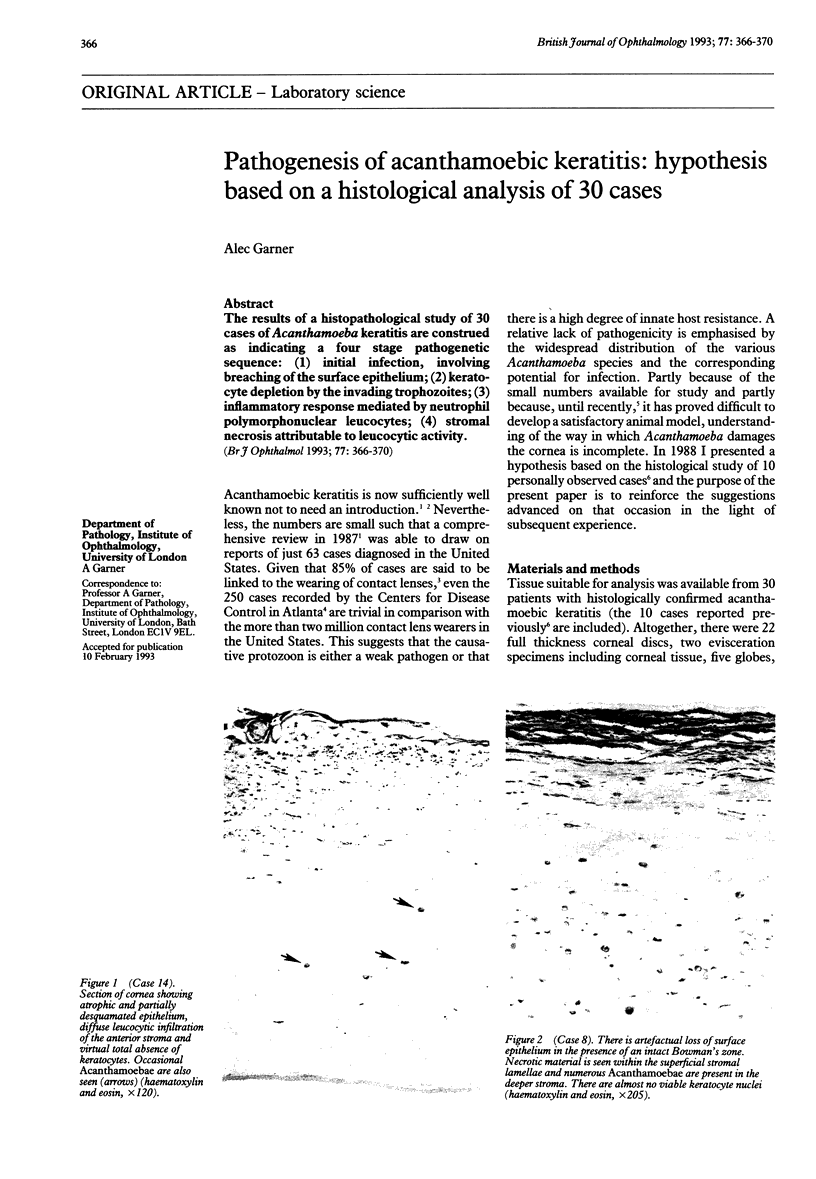
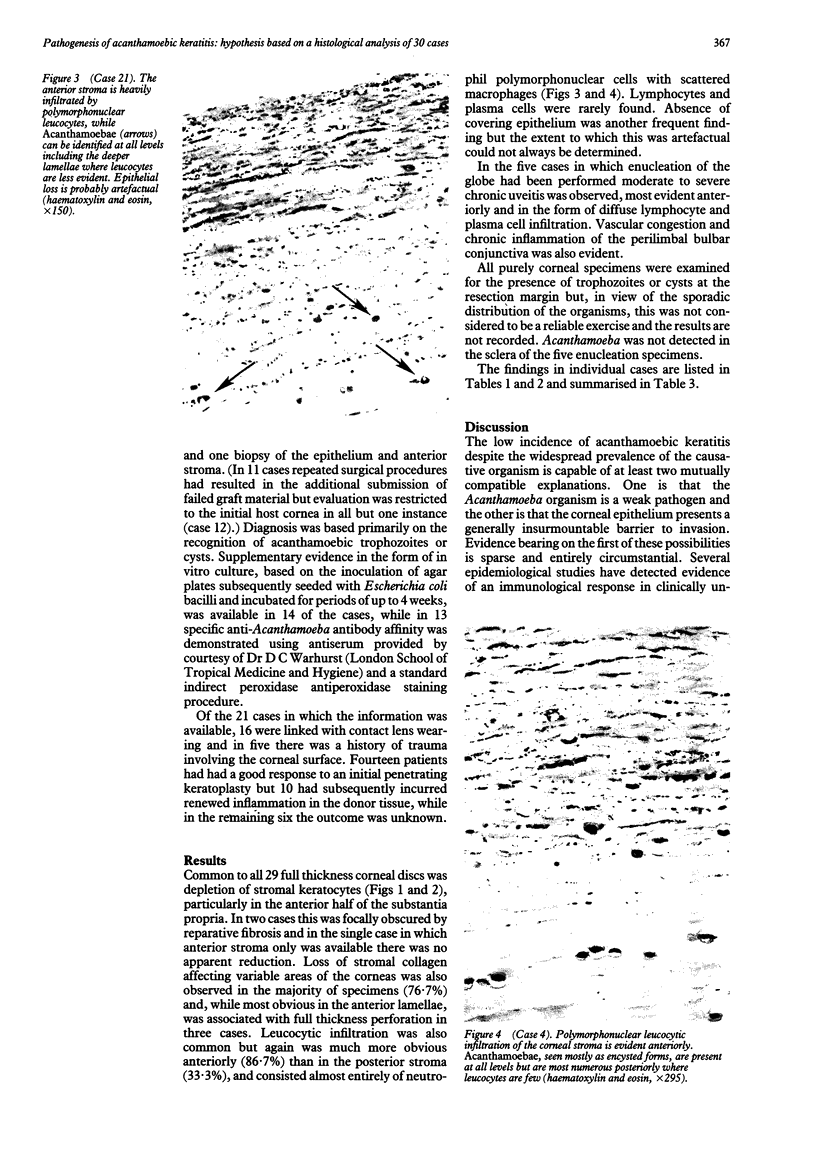
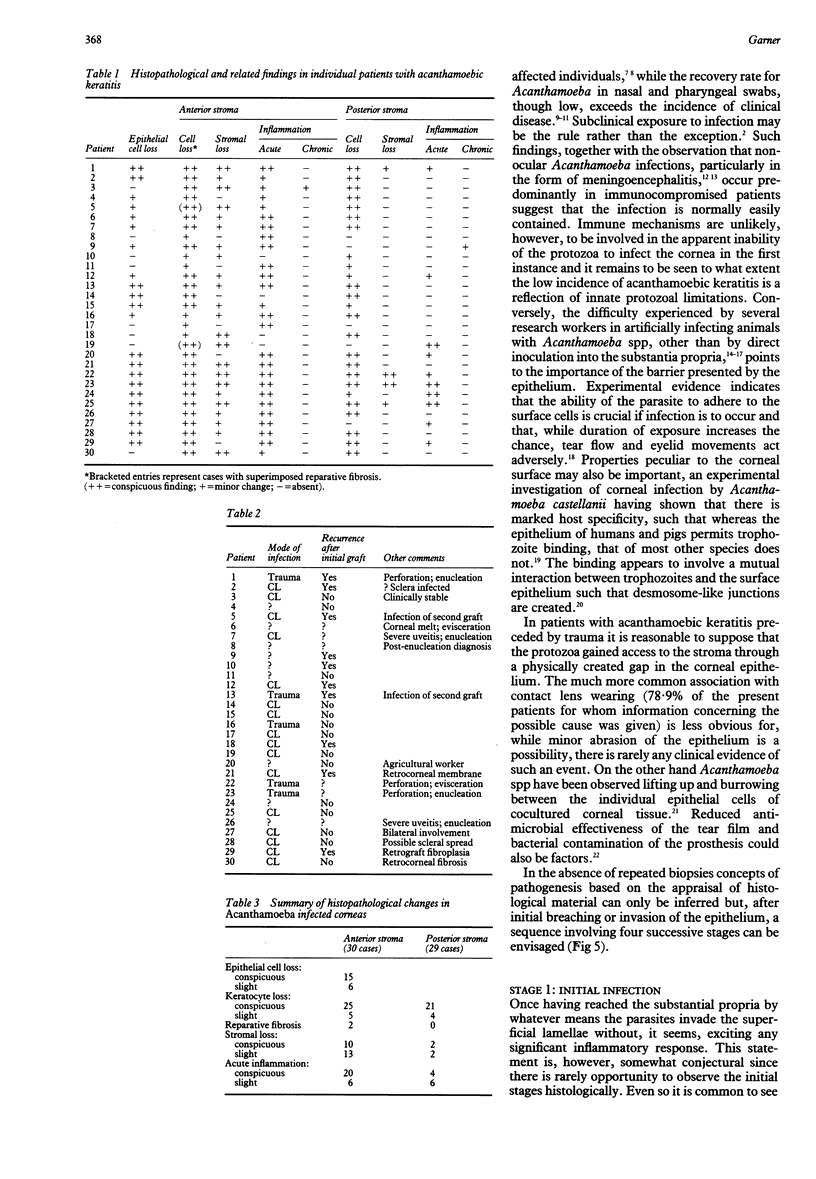
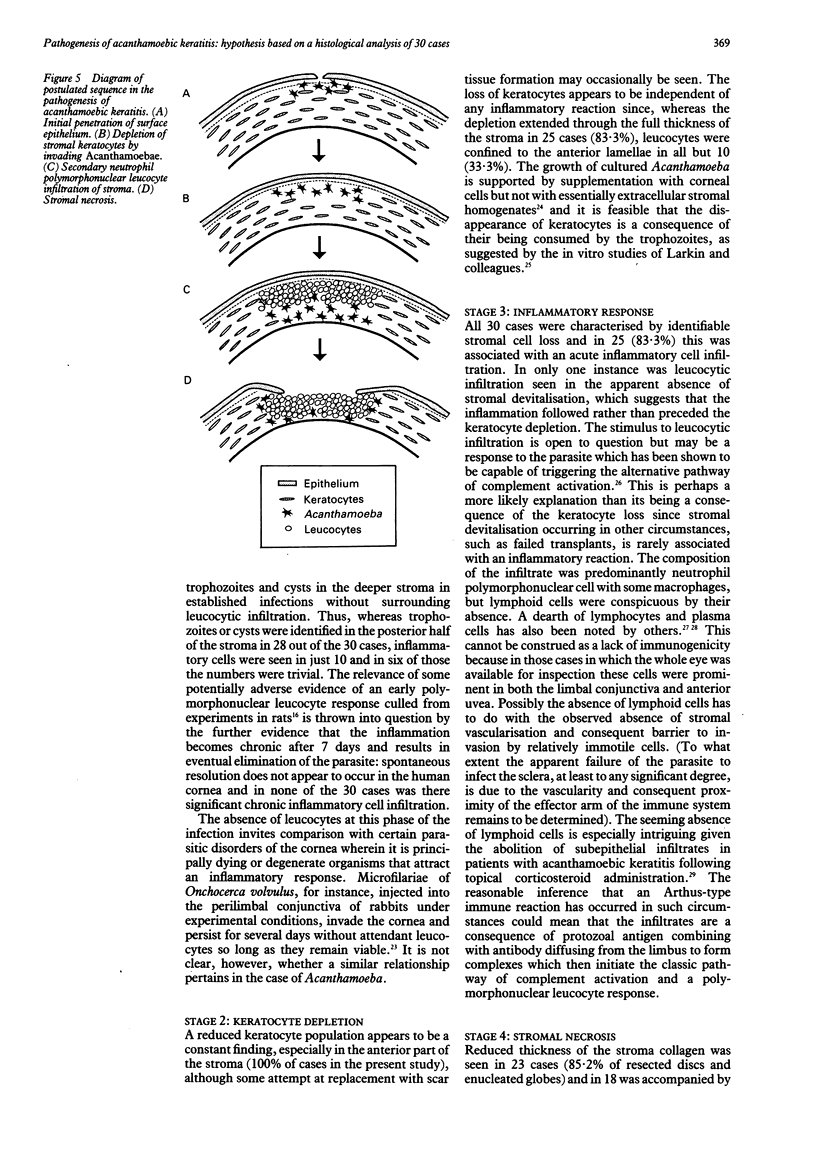
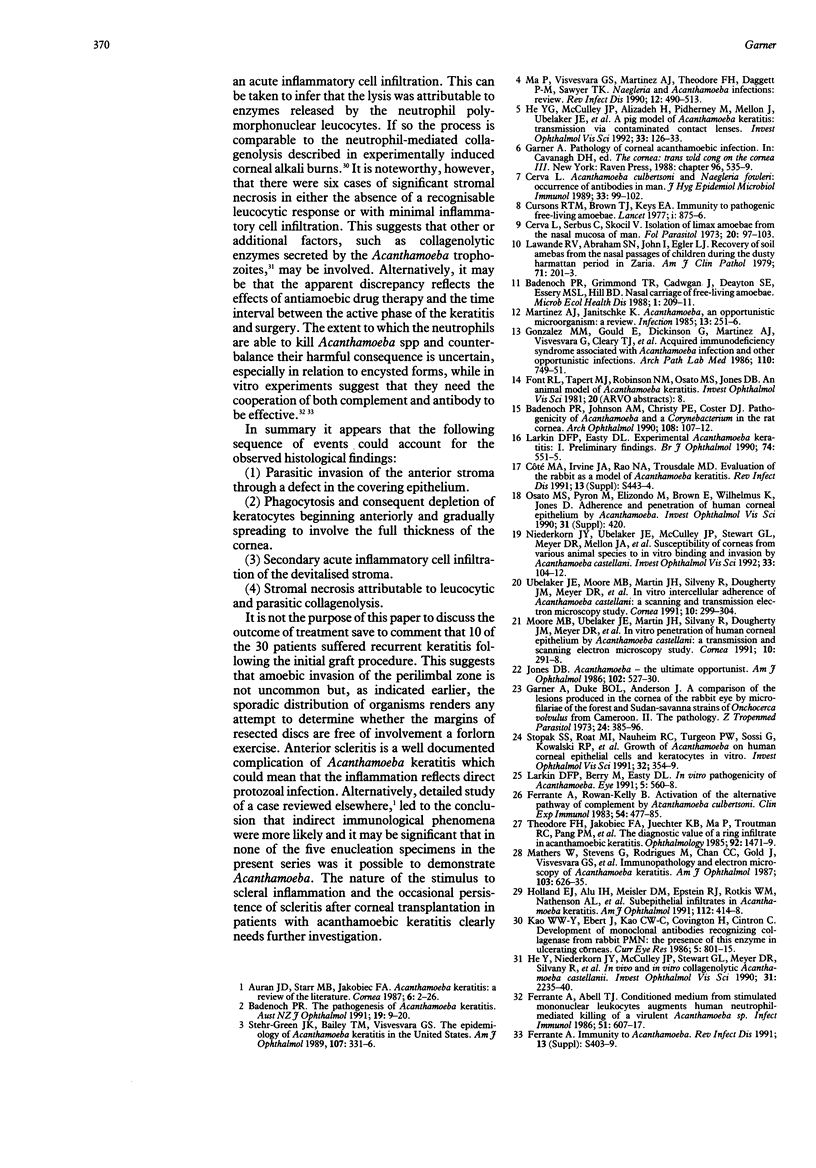
Images in this article
Selected References
These references are in PubMed. This may not be the complete list of references from this article.
- Auran J. D., Starr M. B., Jakobiec F. A. Acanthamoeba keratitis. A review of the literature. Cornea. 1987;6(1):2–26. [PubMed] [Google Scholar]
- Badenoch P. R., Johnson A. M., Christy P. E., Coster D. J. Pathogenicity of Acanthamoeba and a Corynebacterium in the rat cornea. Arch Ophthalmol. 1990 Jan;108(1):107–112. doi: 10.1001/archopht.1990.01070030113040. [DOI] [PubMed] [Google Scholar]
- Badenoch P. R. The pathogenesis of Acanthamoeba keratitis. Aust N Z J Ophthalmol. 1991 Feb;19(1):9–20. [PubMed] [Google Scholar]
- Bridges C. D. Lectin receptors of rods and cones. Visualization by fluorescent label. Invest Ophthalmol Vis Sci. 1981 Jan;20(1):8–16. [PubMed] [Google Scholar]
- Cerva L. Acanthamoeba culbertsoni and Naegleria fowleri: occurrence of antibodies in man. J Hyg Epidemiol Microbiol Immunol. 1989;33(1):99–103. [PubMed] [Google Scholar]
- Cerva L., Serbus C., Skocil V. Isolation of limax amoebae from the nasal mucosa of man. Folia Parasitol (Praha) 1973;20(1):97–103. [PubMed] [Google Scholar]
- Cursons R. T., Brown T. J., Keys E. A. Immunity to pathogenic free-living amoebae. Lancet. 1977 Oct 22;2(8043):875–876. doi: 10.1016/s0140-6736(77)90812-1. [DOI] [PubMed] [Google Scholar]
- Côté M. A., Irvine J. A., Rao N. A., Trousdale M. D. Evaluation of the rabbit as a model of Acanthamoeba keratitis. Rev Infect Dis. 1991 Mar-Apr;13 (Suppl 5):S443–S444. doi: 10.1093/clind/13.supplement_5.s443. [DOI] [PubMed] [Google Scholar]
- Ferrante A., Abell T. J. Conditioned medium from stimulated mononuclear leukocytes augments human neutrophil-mediated killing of a virulent Acanthamoeba sp. Infect Immun. 1986 Feb;51(2):607–617. doi: 10.1128/iai.51.2.607-617.1986. [DOI] [PMC free article] [PubMed] [Google Scholar]
- Ferrante A. Immunity to Acanthamoeba. Rev Infect Dis. 1991 Mar-Apr;13 (Suppl 5):S403–S409. doi: 10.1093/clind/13.supplement_5.s403. [DOI] [PubMed] [Google Scholar]
- Ferrante A., Rowan-Kelly B. Activation of the alternative pathway of complement by Acanthamoeba culbertsoni. Clin Exp Immunol. 1983 Nov;54(2):477–485. [PMC free article] [PubMed] [Google Scholar]
- Garner A., Duke B. O., Anderson J. A comparison of the lesions produced in the cornea of the rabbit eye by microfilariae of the forest and Sudan-savanna strains of Onchocerca volvulus from Cameroon. II. The pathology. Z Tropenmed Parasitol. 1973 Dec;24(4):385–396. [PubMed] [Google Scholar]
- Gonzalez M. M., Gould E., Dickinson G., Martinez A. J., Visvesvara G., Cleary T. J., Hensley G. T. Acquired immunodeficiency syndrome associated with Acanthamoeba infection and other opportunistic organisms. Arch Pathol Lab Med. 1986 Aug;110(8):749–751. [PubMed] [Google Scholar]
- He Y. G., McCulley J. P., Alizadeh H., Pidherney M., Mellon J., Ubelaker J. E., Stewart G. L., Silvany R. E., Niederkorn J. Y. A pig model of Acanthamoeba keratitis: transmission via contaminated contact lenses. Invest Ophthalmol Vis Sci. 1992 Jan;33(1):126–133. [PubMed] [Google Scholar]
- He Y. G., Niederkorn J. Y., McCulley J. P., Stewart G. L., Meyer D. R., Silvany R., Dougherty J. In vivo and in vitro collagenolytic activity of Acanthamoeba castellanii. Invest Ophthalmol Vis Sci. 1990 Nov;31(11):2235–2240. [PubMed] [Google Scholar]
- Holland E. J., Alul I. H., Meisler D. M., Epstein R. J., Rotkis W. M., Nathenson A. L., Liesegang T. J. Subepithelial infiltrates in Acanthamoeba keratitis. Am J Ophthalmol. 1991 Oct 15;112(4):414–418. doi: 10.1016/s0002-9394(14)76250-6. [DOI] [PubMed] [Google Scholar]
- Jones D. B. Acanthamoeba--the ultimate opportunist? Am J Ophthalmol. 1986 Oct 15;102(4):527–530. doi: 10.1016/0002-9394(86)90085-1. [DOI] [PubMed] [Google Scholar]
- Kao W. W., Ebert J., Kao C. W., Covington H., Cintron C. Development of monoclonal antibodies recognizing collagenase from rabbit PMN; the presence of this enzyme in ulcerating corneas. Curr Eye Res. 1986 Nov;5(11):801–815. doi: 10.3109/02713688609029231. [DOI] [PubMed] [Google Scholar]
- Larkin D. F., Berry M., Easty D. L. In vitro corneal pathogenicity of Acanthamoeba. Eye (Lond) 1991;5(Pt 5):560–568. doi: 10.1038/eye.1991.98. [DOI] [PubMed] [Google Scholar]
- Larkin D. F., Easty D. L. Experimental Acanthamoeba keratitis: I. Preliminary findings. Br J Ophthalmol. 1990 Sep;74(9):551–555. doi: 10.1136/bjo.74.9.551. [DOI] [PMC free article] [PubMed] [Google Scholar]
- Lawande R. V., Abraham S. N., John I., Egler L. J. Recovery of soil Amebas from the nasal passages of children during the dusty harmattan period in Zaria. Am J Clin Pathol. 1979 Feb;71(2):201–203. doi: 10.1093/ajcp/71.2.201. [DOI] [PubMed] [Google Scholar]
- Ma P., Visvesvara G. S., Martinez A. J., Theodore F. H., Daggett P. M., Sawyer T. K. Naegleria and Acanthamoeba infections: review. Rev Infect Dis. 1990 May-Jun;12(3):490–513. doi: 10.1093/clinids/12.3.490. [DOI] [PubMed] [Google Scholar]
- Martinez A. J., Janitschke K. Acanthamoeba, an opportunistic microorganism: a review. Infection. 1985 Nov-Dec;13(6):251–256. doi: 10.1007/BF01645432. [DOI] [PubMed] [Google Scholar]
- Mathers W., Stevens G., Jr, Rodrigues M., Chan C. C., Gold J., Visvesvara G. S., Lemp M. A., Zimmerman L. E. Immunopathology and electron microscopy of Acanthamoeba keratitis. Am J Ophthalmol. 1987 May 15;103(5):626–635. doi: 10.1016/s0002-9394(14)74321-1. [DOI] [PubMed] [Google Scholar]
- Moore M. B., Ubelaker J. E., Martin J. H., Silvany R., Dougherty J. M., Meyer D. R., McCulley J. P. In vitro penetration of human corneal epithelium by Acanthamoeba castellanii: a scanning and transmission electron microscopy study. Cornea. 1991 Jul;10(4):291–298. doi: 10.1097/00003226-199107000-00003. [DOI] [PubMed] [Google Scholar]
- Niederkorn J. Y., Ubelaker J. E., McCulley J. P., Stewart G. L., Meyer D. R., Mellon J. A., Silvany R. E., He Y. G., Pidherney M., Martin J. H. Susceptibility of corneas from various animal species to in vitro binding and invasion by Acanthamoeba castellanii [corrected]. Invest Ophthalmol Vis Sci. 1992 Jan;33(1):104–112. [PubMed] [Google Scholar]
- Stehr-Green J. K., Bailey T. M., Visvesvara G. S. The epidemiology of Acanthamoeba keratitis in the United States. Am J Ophthalmol. 1989 Apr 15;107(4):331–336. doi: 10.1016/0002-9394(89)90654-5. [DOI] [PubMed] [Google Scholar]
- Stopak S. S., Roat M. I., Nauheim R. C., Turgeon P. W., Sossi G., Kowalski R. P., Thoft R. A. Growth of acanthamoeba on human corneal epithelial cells and keratocytes in vitro. Invest Ophthalmol Vis Sci. 1991 Feb;32(2):354–359. [PubMed] [Google Scholar]
- Theodore F. H., Jakobiec F. A., Juechter K. B., Ma P., Troutman R. C., Pang P. M., Iwamoto T. The diagnostic value of a ring infiltrate in acanthamoebic keratitis. Ophthalmology. 1985 Nov;92(11):1471–1479. doi: 10.1016/s0161-6420(85)33830-7. [DOI] [PubMed] [Google Scholar]
- Ubelaker J. E., Moore M. B., Martin J. H., Silveny R., Dougherty J. M., Meyer D. R., McCulley J. P. In vitro intercellular adherence of Acanthamoeba castellanii: a scanning and transmission electron microscopy study. Cornea. 1991 Jul;10(4):299–304. doi: 10.1097/00003226-199107000-00004. [DOI] [PubMed] [Google Scholar]



